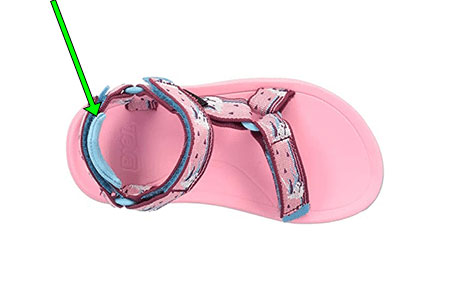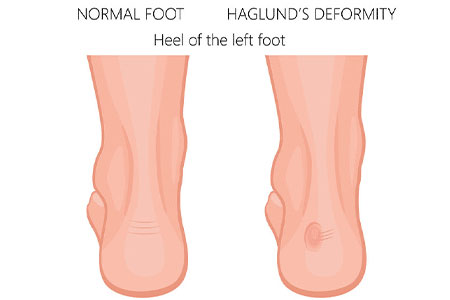Best Sandals for Kids with Haglund’s Deformity – Adjustable Straps and Extra Padding!

Have you noticed your child limping and complaining about heel pain? Has your medical professional diagnosed your child with Haglund’s deformity? One of the most effective ways to treat this condition is by wearing soft-backed shoes to help avoid or minimize irritation in the heel area. Orthotics, as well as physiotherapy, are also effective ways of treating this condition. In this resource, I will show you a list of the best sandals for kids with Haglund’s deformity.
Pediatricians and physical therapists refer children to the specialized shoe store that I work for to be fitted for the correct type of shoes and depending on the degree of the child’s foot condition, orthotics as well.
When children walk to the shoe store I work for with this condition I start by making sure they are not wearing shoes with rigid heel counters, as this can aggravate the enlargement by causing irritation.
Did you know that Haglund’s deformity is also referred to as “pump bump”? This is because shoes with rigid backs apply extra friction and pressure which irritates the heel bone, causing the characteristic swelling and pain of the condition.
What Causes Children to Develop Haglund’s Deformity?
Medical professionals believe that the three main causes of this condition are:
- Having high arches
- Having a tight Achilles tendon
- Heredity
I have noticed that most children who have high arches or supination and walk on the outside of their heels are more prone to develop this condition.
Examples of Children with Haglund’s Deformity
Below you can find some examples of children with Haglund’s deformity that I helped find the correct pair of shoes for their feet:



While many medical professionals recommend wearing shoes with open backs this is not possible for most children as the shoes need to provide them with a certain degree of support and stability.
Can you imagine walking around in flip-flops all day? Shoes with open backs can easily overtire your child’s feet and cause tendon problems. Your child’s toes will have to work extra hard to keep the shoes on, and this can cause stiffness and pain.
What Makes the Sandals I Recommend Effective for Haglund’s Deformity?
The sandals I recommend come with open backs but with adjustable and cushioned straps that will allow your child to adjust how much pressure to put around the heels.
1️⃣ Extra Padding and Cushion: Notice how the sandals I recommend provide extra cushion and padding right where your child’s heels are:

Let’s take a closer look at this awesome feature:

2️⃣ Adjustable Straps: The sandals I recommend can be adjusted in 3 different places. The most important factor is that the sandals can be adjusted around the heels, that way your child can adjust how much pressure to put on the bump:

Below you can find a list of the best sandals for kids with Haglund’s deformity. Disclosure: Keep in mind that we may receive commissions when you click our links and make purchases.
Best Sandals for Kids with Haglund’s Deformity
Take a look at the description below each sandal to find out whether it can accommodate your child’s foot shape (medium, wide), and to find out what additional features each sandal provides.
Open Toe Sandals
- Shoe style Hurricane by Teva
- Fits medium and wide feet
- 3 points of adjustability so children can make the sandals as tight or loose as they want
- Eva foam footbed cushions and softly supports for all day comfort
- Rigid at the toe box
- Order this sandal a whole size larger than your child’s current foot size
- Shoe style Hurricane by Teva
- Fits medium and wide feet
- 3 points of adjustability so children can make the sandals as tight or loose as they want
- Eva foam footbed cushions and softly supports for all day comfort
- Rigid at the toe box
- Order this sandal a whole size larger than your child’s current foot size
- Shoe style Adventure Seeker by Timberland
- Fits medium and wide feet
- Two adjustable straps with hook-and-loop closure
- Eva foam footbed cushions and softly supports for all day comfort
- Order this sandal half a size larger than your child’s current foot size
- Shoe style Adventure Seeker by Timberland
- Fits medium and wide feet
- Two adjustable straps with hook-and-loop closure
- Eva foam footbed cushions and softly supports for all day comfort
- Order this sandal half a size larger than your child’s current foot size
Closed Toe Sandals
- Shoe style Motozoa by Keen
- Fits medium and wide feet
- 2 adjustable velcro straps for easy on and off
- Extra padding around the straps
- Order this sandal a whole size larger than your child’s current foot size
- Shoe style Motozoa by Keen
- Fits medium and wide feet
- 2 adjustable velcro straps for easy on and off
- Extra padding around the straps
- Order this sandal a whole size larger than your child’s current foot size
How to Retrieve Your Child’s Exact Foot Length and Shape
If you want to be 100% sure about what shoe size to order online, I suggest that you follow the instructions in a different article I created.
What Are the Best Sneakers for Kids with Haglund’s Deformity?
If you are looking for a pair of everyday sneakers that your child can wear I suggest that you take a look at the article below. The shoes described in that article provide extra cushioning and padding around the heel area, which helps minimize painful pressure and friction.
Are There Any Other Sandal Choices Available?
If the sandals are not available in your child’s size or if you don’t seem to find any sandals that you or your child likes do not hesitate to contact me and I will do my best to find you an alternative:
If this condition doesn’t improve your doctor might require surgery, so please make sure that you take the necessary steps to prevent this condition from getting worse.







